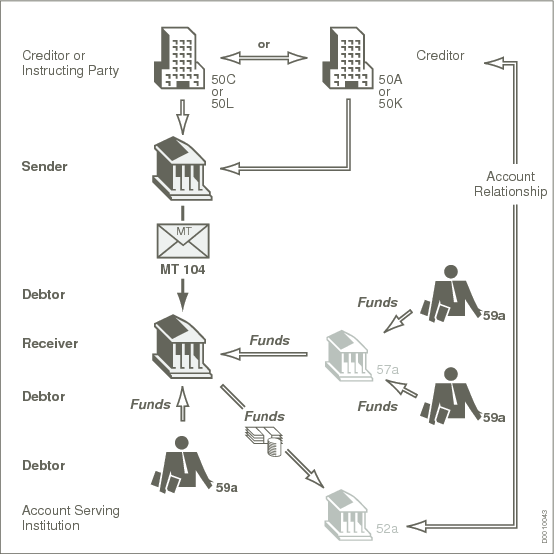The MT 104 message can be exchanged in two different Message Users Groups (MUGs), depending on the business scenario for which the message is used.
The Direct Debit MUG, allows its subscribers to exchange Direct Debit instructions via an MT 104; proceeds of the Direct Debits being credited to the Sender's account at the Receiver and ultimately to the Ordering Customer/Instructing Party.
The Request for Direct Debit MUG allows its subscribers to exchange request for Direct Debit instructions via an MT 104; proceeds of these Direct Debits being directly credited to a customer's account maintained at the Receiver.
Depending on the MUG that is used, certain fields are subject to special validation (see network validated rules and field specifications). They can only be used by the institutions who have registered in the corresponding MUG.
If the Sender has registered in the Request for Direct Debit MUG and wants to send a Request for Direct Debit message, he must set the validation flag -field 119 of the User Header- of the message to "RFDD" which indicates that the message is a Request for Direct Debit.
If the Sender has registered in the Direct Debit MUG and wants to send a Direct Debit message, he must not use the validation flag -field 119 of the User Header- of the message.
The MT 104 under the "Direct Debit Order" MUG

In this scenario there can be one or several instructing parties and one or several ordering customers ordering direct debits to be processed in the receiving country with a repatriation of funds on sending bank's account and then on the creditor's account.
The MT 104 under the "Request for Direct Debit" MUG

The parties mentioned in the chain are not necessarily different entities. The first column of the table below shows the parties that can be omitted in an MT 104. The second column specifies the party which assumes the role of the party in the first column, when it is not present:
The use of the MT 104 is subject to bilateral/multilateral agreements between the Sender and the Receiver. Amongst other things, these bilateral agreements cover information about transaction amount limits and definitions of direct debit schemes. The MT 104 Checklist at the end of this chapter is recommended as a guide for institutions in the setup of their agreements.